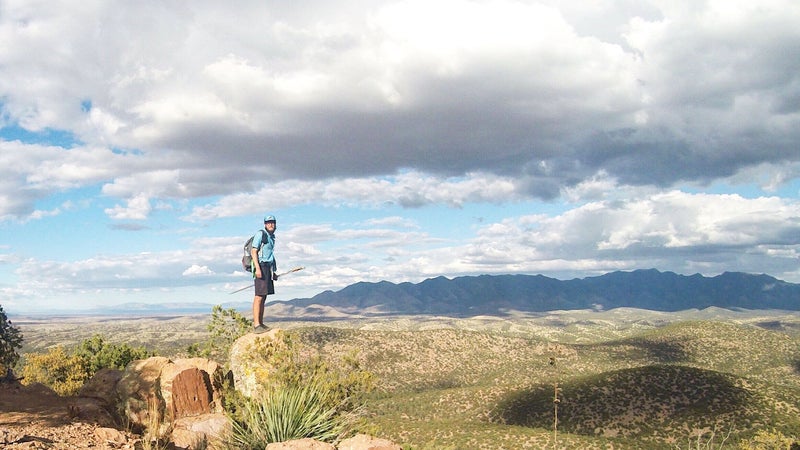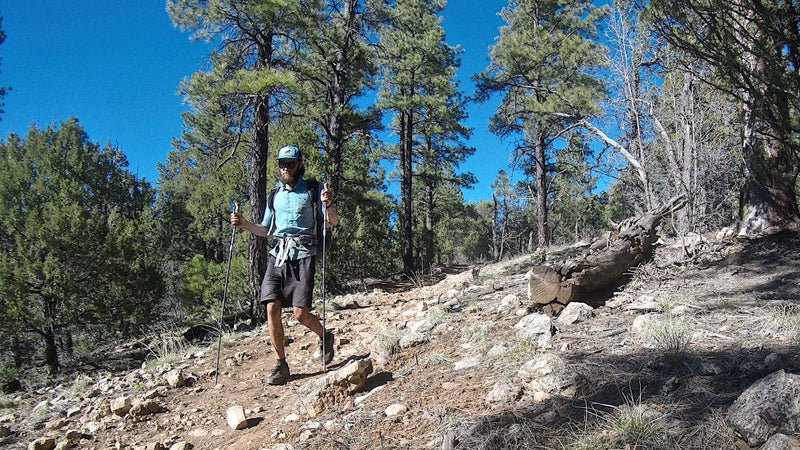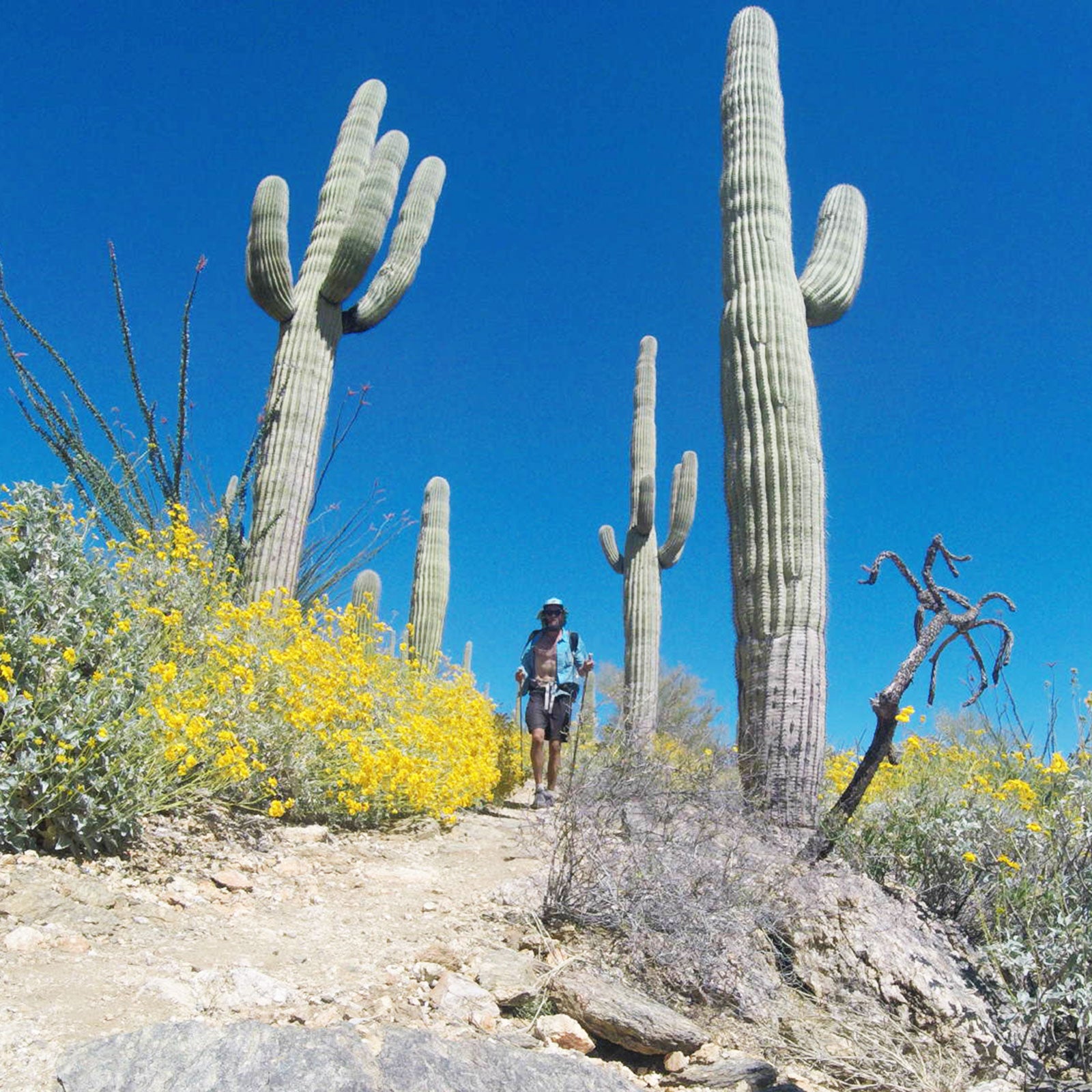(AZT) spans 800 miles from Mexico to Utah, winding through deserts, mountains, forests, and canyons. Elevation ranges from 1,700 to 9,148 feet. It’s challenging to complete the AZT at any speed, much less Jeff Garmire’s (FKT) of 15 days, 13 hours, and 10 minutes.
Fending off sleep deprivation and hallucinations, Garmire completed the trail and set the record��on April 21, 2019. He averaged over 50 miles per day,��self-supported. To put this into perspective, Garmire ran about two marathons a day, sleeping an average of four hours per night, and repeated the process for 15 and a half days. The previous for the trail was 18 days, 16 hours, and 45 minutes, by Whitt “El Matador”��Wisebram in November 2018, and the record for a ��was 15 days, 22 hours, and 39 minutes, by Michael Versteeg in October 2016.��
Thru-hiking isn’t new to Garmire. In 2016, he completed a calendar-year triple crown (the Appalachian Trail, Continental Divide Trail, and Pacific Crest Trail). And in 2018,��he completed the Great Western Loop, which links portions of five��different long-trails and spans nearly 7,000 miles. With a trail name like “Legend” and�� under his belt, it’s not surprising to hear that a massive FKT like the Arizona Trail was on Garmire’s list. “I wanted to see if my body could handle something I hadn’t tried before,” he says.
So��how did he do it?
How Garmire Trained for the AZT
A feat like this requires substantial preparation, and Garmire provided some insight into his training regimen for the trail. “I spent the winter in [Lake] Tahoe. In February alone, there were��25 feet of snow. So��most of my training involved skiing and running on snow in cleats,” he says.��He usually logs miles to measure his level of fitness, but the high snow levels in Tahoe forced him to recalibrate. Plus, running in cleats in the snow offered more of a challenge than actual miles. He ultimately determined that time spent moving was just as important. For a few weeks during that period, Garmire was logging as many��as 65 miles of running in a week, along with two to three hours of skiing each day.��
Another part of Garmire’s strategy was to get onto the actual AZT before attempting the FKT. Last year��on the Great Western Loop, he hiked about 500 miles of it. But he wanted to get a feel for the remaining section. So��he casually—which meant some 35-mile days—did the rest of the trail the week before starting his attempt.��Getting on the AZT��early helped him scope out conditions and water sources while evaluating his fitness level.

How He Kept Going
Garmire delayed his start date by a day after a windy night kept him awake and fed his anxiety, so he went to Sierra Vista, a town near the southern end of the trail, to regroup. He swears��that timing made all of the difference. Right out of the gate, he tucked 47.6 miles behind him on the first day. At first��he was averaging between 46 and 52 miles per day, but by day eight��he started to show signs of serious complications. His feet suffered as his energy waned. The margin for error was unforgiving.
He����on day 14,��making it his longest and most grueling day.��: “It was not a good morning. I hit snooze on my alarm until I didn’t even need a headlamp to move. Mentally I was out of it and felt like throwing in the towel. My body was wrecked and I just wanted to sleep. This was not fun. It was brutal and I questioned why I had put myself through this. But while all these thoughts went through my head, I pushed forward. Then the slog continued into the night and I started going crazy. I couldn’t stop, but I also couldn’t stop the strange things going through my mind.”
Sleeping fewer hours each night as his pace slowed, Garmire started experiencing hallucinations. Suddenly, a clump of trees looked like a witch on a broomstick or a Sasquatch in the distance. While he knew that his mind was playing tricks on him, he also recognized the strain he was putting on himself.
Despite the challenges, he found a way to maintain a positive attitude, often using mantras or listening to loud music to ramp up his spirits. “I don’t think quitting was ever an option,” he says.
Still, the trail took its toll on his body.��“I lost close to 12 pounds,” he said. While shedding weight at a startling rate, Garmire also had to deal with shredded feet, which meant slapping some duct tape on his toes and admiring his “hiker pedicure.”
How He Fueled His FKT
Garmire’s strategy was to eat as much real food as possible.��He relied heavily on wraps, plopping salami and cheese onto a tortilla. He also designed his own thru-hiker delicacy, the result of eating out of gas stations for long-stretches of trail: “a staple of my diet would be hot dog buns, mayo and mustard packets, with individual cheese sticks and beef jerky in them,”��.��“The Garmire Supreme” was sometimes his best resupply option.��
He used a combination of local resupplies, buying food as he went, and mail drops waiting for him in post offices along the way to get his food. Sometimes Garmire opted for the more convenient resupply point, wandering the aisles of a forlorn service station rather than wasting valuable minutes to get to a real grocery store.
How He Hiked His��Own Hike
Attempting to label record setters on the trail can be complicated and confusing. Are you a thru-hiker or an ultrarunner? Does your strategy determine how you categorize yourself? Can you be categorized at all?
“I’m a thru-hiker. I definitely run, too, but I think thru-hikers are just as badass. This is a thing I’ve battled with a lot. If two people race on the John Muir Trail, and one is an ‘ultrarunner’ while the other is a ‘thru-hiker,’ they’ll have the same times but define themselves differently. It sounds more athletic if you say you ran��the John Muir Trail,” Garmire says. He suggests that these two kinds endurance athletes share a blurred line. Record setters rely on efficiency and speed to explore human potential. But strategies to cut time can differ.��

For Garmire, his��personal goal is to push his limitations, but he’s clear that hiking doesn’t have to be about speed. Your own personal gratification should come first.
“Some people don’t think you should do trails fast. There’s no one right way to do a trail. Hike your own hike,” Garmire says.


